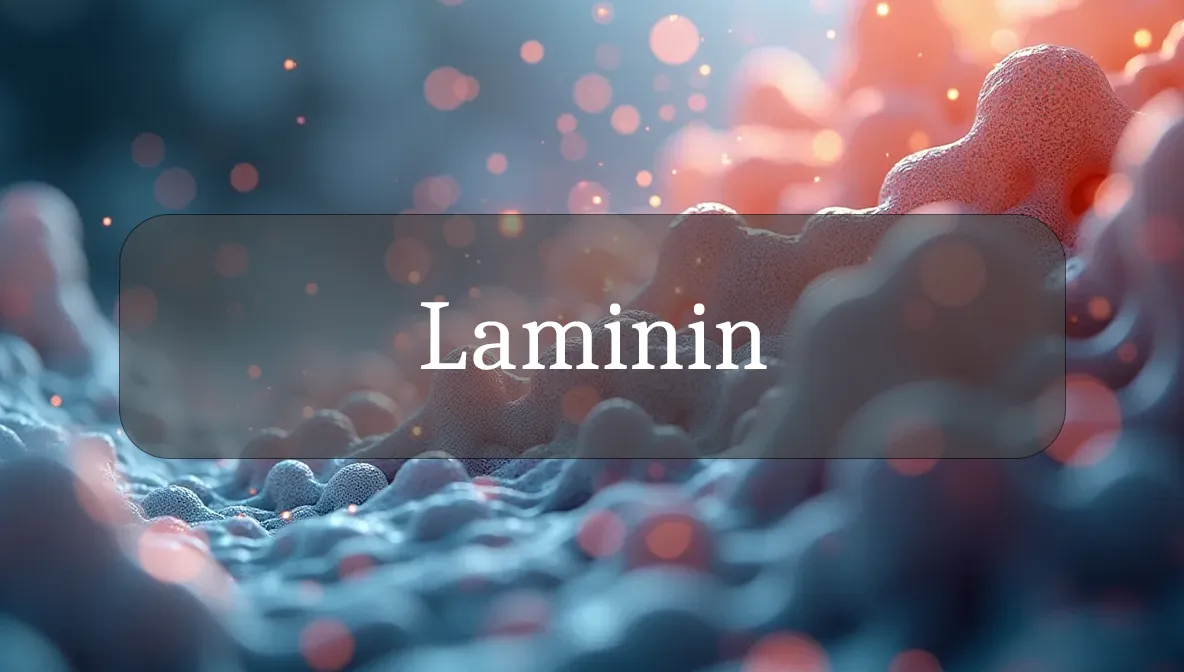Protein That Anchors Tissues and Supports Cell Health
Laminin is like your body’s glue and scaffolding, a protein that holds cells together, supports tissue structure, and aids in cell signaling. It’s a key player in daily wellness, ensuring strong tissues, healthy organs, and efficient repair. Let’s explore what laminin is, how it benefits your health, and practical ways to support its function—all in a clear, friendly way to empower your wellness journey.
Chemical Identity and Type
Laminin is a glycoprotein, a large protein with attached sugar molecules, composed of three chains (α, β, γ) rich in amino acids like glycine, proline, and cysteine. Encoded by genes like LAMA, LAMB, LAMC, it forms a cross-shaped structure in the extracellular matrix, found in basement membranes (thin layers supporting cells in tissues like skin, muscles, and organs). Laminin acts as a body signal, binding to integrins and other receptors to anchor cells and regulate tissue function. It’s synthesized in your body, not consumed directly.
Biological Role and Benefits
Laminin is your body’s structural anchor, supporting tissue integrity and cell communication. Here’s how it contributes to your wellness:
- Tissue Stability: Laminin anchors cells to basement membranes in skin, muscles, nerves, and organs, maintaining structural integrity.
- Cell Adhesion: It helps cells stick together, ensuring strong tissues like skin and blood vessels.
- Wound Healing: Laminin guides cell migration and tissue repair, speeding recovery from injuries.
- Nerve Function: It supports nerve growth and repair, promoting healthy brain and nervous system function.
- Organ Health: Laminin maintains the structure of organs like kidneys, lungs, and heart, supporting their function.
By supporting these processes, laminin enhances tissue strength, repair, and overall vitality.
Dietary or Natural Sources
Your body produces laminin from amino acids, supported by a nutrient-rich diet. Key sources to promote laminin synthesis and tissue health include:
- Protein-Rich Foods: Eggs, chicken, fish (salmon, tuna), beef, and lentils (provide glycine, proline, and cysteine for laminin synthesis).
- Collagen-Boosting Foods: Bone broth, fish skin, and gelatin (support extracellular matrix proteins).
- Nutrient Boosters: Vitamin C (oranges, bell peppers), zinc (oysters, seeds), manganese (nuts, whole grains), and vitamin A (carrots, sweet potatoes) support tissue health and protein synthesis.
- Anti-Inflammatory Foods: Fatty fish (rich in omega-3s), turmeric, and berries reduce inflammation, aiding laminin function.
- Hydration: Water (8–10 cups daily) maintains tissue hydration and supports extracellular matrix function.
No laminin supplements exist, as it’s made in the body. Collagen supplements (5–10 grams daily) or vitamin C (500–1,000 mg daily) may support related tissue health, but consult a doctor first. Aim for 0.8–1.2 grams of protein per kilogram of body weight daily (e.g., 56–84 grams for a 150-pound person).
Signs of Imbalance or Dysfunction
Laminin dysfunction, often from genetic mutations or aging, can affect tissue health. Signs include:
- Low Laminin:
- Weakened tissues, leading to fragile skin or poor wound healing.
- Muscle weakness or neurological issues (e.g., in muscular dystrophy).
- Increased risk of tissue damage in organs like kidneys or lungs.
- Joint or connective tissue problems.
- Excess Laminin (Rare):
- Abnormal tissue growth or fibrosis in specific conditions.
- Linked to certain cancers (under research).
Low laminin may stem from genetic disorders (e.g., congenital muscular dystrophy, LAMA2-related conditions), poor nutrition, or aging. Excess is rare but may occur in fibrotic or tumor-related conditions.
Supporting Optimal Levels or Function
To keep laminin functioning well and maintain its benefits, try these practical steps:
- Eat a Tissue-Healthy Diet: Include protein (eggs, fish), collagen-rich foods (bone broth), and vitamin C (berries, peppers) to support laminin synthesis.
- Boost Supporting Nutrients: Consume zinc (seeds, oysters), manganese (nuts, oats), vitamin A (carrots, spinach), and omega-3s (salmon, walnuts) for tissue health.
- Stay Active: Moderate exercises like yoga, walking, or strength training (3–5 times weekly) promote tissue repair and extracellular matrix health.
- Get Enough Sleep: Aim for 7–9 hours to support tissue regeneration and reduce inflammation.
- Manage Stress: Chronic stress increases inflammation, potentially disrupting laminin; try meditation or deep breathing.
- Stay Hydrated: Drink 8–10 cups of water daily to maintain tissue hydration and matrix function.
- Consider Supplements: Collagen (5–10 grams daily) or vitamin C (500–1,000 mg daily) may support tissue health, but consult a doctor.
Safety, Interactions, and Precautions
Laminin is naturally produced and safe when balanced, but consider these points:
- Genetic Conditions: Disorders like LAMA2-related muscular dystrophy involve laminin dysfunction, requiring specialized medical care.
- Supplements: Collagen or vitamin C are safe but may cause digestive upset in high doses (e.g., above 2,000 mg for vitamin C).
- Allergies: Fish- or bovine-based collagen supplements may trigger reactions in sensitive individuals.
- Medical Conditions: Chronic inflammation or tissue disorders may affect laminin; consult a doctor for tailored care.
- Medications: Anti-inflammatory drugs or immune modulators may influence laminin-related processes; check with your doctor.
Focus on a nutrient-rich diet, hydration, and exercise to support laminin naturally.
Fun Fact
Did you know laminin’s cross-shaped structure inspired scientists to call it the “glue of life”? It literally holds your tissues together, keeping your body’s architecture intact!
Citations
- National Institutes of Health. (2023). Laminin and extracellular matrix health. MedlinePlus.
- Mayo Clinic. (2024). Nutrition for tissue and skin health.
- Cleveland Clinic. (2022). The role of laminin in tissue structure and repair.
- World Health Organization. (2020). Nutrient requirements for health.
- National Institute of Neurological Disorders and Stroke. (2023). Laminin in muscular dystrophy.

